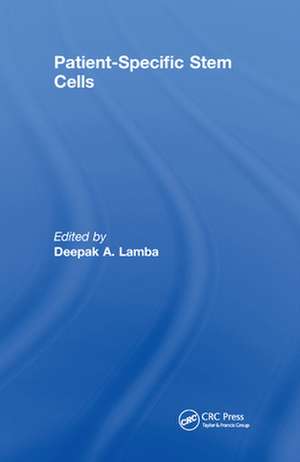Patient-Specific Stem Cells
en Limba Engleză Paperback – 29 sep 2020
The discovery of human pluripotent stem cells in 1998 followed by the technological advances to reprogram somatic cells to pluripotent-stem cell-like cells in 2006 has completely revolutionized the way we can now think about modelling human development and disease. This now coupled with genome editing technologies such as TALENS and CRISPRs have now set us up to develop in vitro models both 2D as well as 3D organoids, which can more precisely reflect the disease in the patients. These combinatorial technologies are already providing us with better tools and therapeutics in drug discovery or gene therapy.
This book summarizes both the technological advances in the field of generation of patient specific lines as well as various gene editing approaches followed by its applicability in various systems. The book will serve as a reference for the current state of the field as it:
-Provides a comprehensive overview of the status of the field of patients derived induced pluripotent stem cells.
-Describes the use of cardiac cells as a main featured component within the book.
-Examines drug toxicity analysis as a working example throughout the book.
Preț: 459.60 lei
Preț vechi: 540.70 lei
-15% Nou
Puncte Express: 689
Preț estimativ în valută:
87.95€ • 91.30$ • 73.34£
87.95€ • 91.30$ • 73.34£
Carte tipărită la comandă
Livrare economică 25 martie-08 aprilie
Preluare comenzi: 021 569.72.76
Specificații
ISBN-13: 9780367868017
ISBN-10: 0367868016
Pagini: 280
Dimensiuni: 156 x 234 mm
Greutate: 0.41 kg
Editura: Taylor & Francis Ltd.
ISBN-10: 0367868016
Pagini: 280
Dimensiuni: 156 x 234 mm
Greutate: 0.41 kg
Editura: Taylor & Francis Ltd.
Notă biografică
Deepak A. Lamba is an Assistant Professor at the Buck Research Institute on Aging, Novato, USA, an Affiliate Assistant Professor, at the University of Washington, Seattle, USA, and an Adjunct Faculty at the Leonard Davis School of Gerontology, University of Southern California, USA.
Cuprins
- Human induced pluripotent stem cells: derivation
- Human induced pluripotent stem cells: banking, and characterization
- Genetic and Epigenetic considerations in iPSC technology
- CRISPR-based genome engineering in human stem cells
- Stem cells for Parkinson¿s disease
- Huntington¿s Disease and Stem Cells
- Applications of Pluripotent Stem Cells in the Therapy and Modeling of Diabetes and Metabolic Diseases
- The Role of iPSCs in Disease Modeling: Gaucher Disease and Related Disorders
- Role of induced pluripotent stem cells in urological disease modeling and repair
- Induced Pluripotent Stem Cells ¿ a Research Tool and a Potential Therapy for RPE-associated Blinding Eye Diseases
- Modeling Neuro-Retinal Development and Disease in Stem Cells
